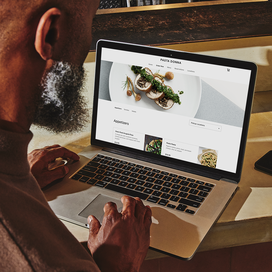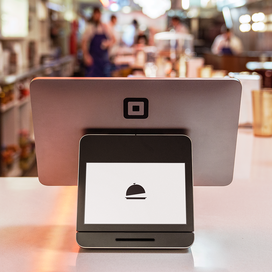Still, it can be a daunting process. Which is why we’ve done the hard work for you and created a step-by-step guide.
Make your menu design work for you.
If you’ve spent time crafting great food, then you need something that showcases it to its best advantage.
You want the most prominent items on your menu to be your most profitable, so make sure diners see them and order them time and time again. And you want your servers to be able to upsell easily with your sides and add-ons well displayed.
Your menu should also embody your brand. You want to create a seamless, cohesive experience for your diners from the moment they enter. That way, they’ll remember you for all the right reasons long after they’ve paid the bill and gone home.
How many items should I put on my menu?
While there’s no hard and fast rule, you can have too much of a good thing. Not only can a huge menu hurt your profitability, it has been proven that people can only remember so much at any one time. Seven is the so-called sweet spot — diners feel like they have just enough choice without being overwhelmed. Of course, seven is a bit limiting and most restaurants will have more options. So consider grouping items together under different subheadings.
How to make a menu
In an ideal world, we’d all pay a professional, but there are some great user-friendly design platforms out there for even the most technophobic restaurateur.
We’ve taken some of the guesswork out by creating menu templates to suit every eatery. At the end of the day, a restaurant menu is pretty subjective and dependent on many different factors — style, brand, items, customer needs — so each one will look very different, but these templates can give you a great head start.
Write down all menu items.
It seems obvious, but put pen to paper and make a list of every single item you plan to sell. If not pen and paper, then use Excel, Google Sheets, or your restaurant POS system to keep track of menu items. When you think about how to make a restaurant menu, it’s simply good practice to have it all laid out in front of you from the get-go so nothing gets missed.
Categorize your menu items.
Next up, organize your items into different categories that suit your style of restaurant. Categories can be food-based, e.g., meat, fish, salad, pizza; course-based, e.g., brunch, starter, sides, dessert, etc.; or dietary-based, e.g., vegan, vegetarian, gluten free. Or they can be a mixture of all those things. Within those categories, you want to organize it so the most popular and profitable items appear near the top.
Write down prices for all menu items.
At this stage, pricing merits a closer look. If this is your first menu, you’ll need to work out what to charge for each dish to achieve the profit margin you want and the best way to display this.
If you’re updating an existing menu or adding in seasonal menu updates, an old menu can act as a guide. But beware of heavily increasing costs at one time or you could alienate existing customers. You can also look at data from your restaurant POS system for accurate info on bestsellers. Aside from working out your margins on each dish, make sure to research your market. Understand what diners pay for similar dishes in your area and figure out what the highest and lowest prices you can charge would be. Then, choose a price in between that will cover your overheads and leave you in profit.
Displaying sides as an extra that diners can choose to have (or not) can be an effective way of achieving the price you want without putting them off.
Create descriptions for all dishes.
You could hire a copywriter, but often the best description will come from the creator. If that’s you, think about why you created each dish and what it means to you. If it’s your chef, ask them for their opinion instead.
Put yourself in your diners’ shoes. Imagine what it’s like to view your menu for the first time. Use plenty of adjectives to describe the food (e.g, refreshing, spicy, tangy, crunchy, velvety), but don’t go over the top.
Choose a color scheme and branding.
There’s a lot of science behind colors and how they affect people’s perception. But whatever you do should align with your brand, including colors, font, and style. Try to stick to three main or complementary colors. Too many can be distracting and draw attention away from the most important thing: the dishes.
Putting your menu together
So, you’ve gathered all your data, written stellar descriptions, and know exactly what profit you make on each item. Now it’s time to craft your menu.
You can use Word or Google Docs, but you may also be starting from scratch when designing it. If this isn’t your forte, it could be a struggle. There are different design software options available, like Canva or Adobe, and we’ve created these easy-to-use menu templates to get you off to a flying start.
However you choose to write your menu, follow this advice:
- Keep it simple – Too much choice can be a bad thing and diners will be put off if they have pages and pages to read through.
- Minimize the $ signs – Don’t hide prices, but don’t draw too much attention to them either, e.g., highlighting them in bold. Consider removing $ signs altogether, as research has shown customers spend significantly more when they’re not on the menu.
- Best item placement – Consider placing your top sellers in areas eyes where eyes go to and less profitable items lower down. When we read, our eyes are drawn to the middle of the page then top right (it’s why newspapers put their best stories on the right hand page).
Menu design top tips
We hope your design is looking pretty special by now. Here are few final thoughts to help optimize your menu:
Should I include photos on my menu?
There’s no hard and fast rule, but too many photos can make a menu look cheap and undermine the vibe you wish to achieve. If you do want to include images, be selective about what you do and hire a professional photographer to make your dishes look their best.
Selecting the right fonts
Ideally, this should align with your branding and you should opt for the same or similar fonts. A menu needs to be easy to read. If you’ve used a very curly script or gothic style in your logo, you should look for something simple for your menu.
Proofreading
Once you’ve finished your menu, get others to read through it. Fresh pairs of eyes can help pick out glaring errors and silly mistakes that can be easily missed.
Sending your menu to print
Once you’re confident it’s perfect, you can get it printed. Make sure you have the right bleed margins in place (this is the area that gets cropped by printers). Templates will usually have this built in, but you should also be able to add one in your design software. Find a local printer or use an online service like Vistaprint or Printed.












